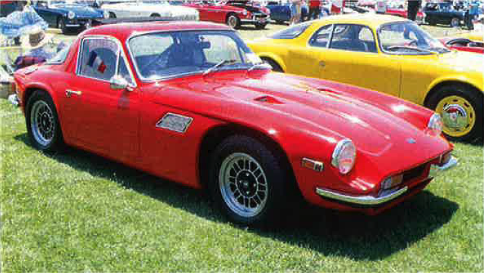TVR: An intriguing example of Britain’s automotive cottage industry
By Harry Newton
A few years ago, while we were cruising along on the Autobahn at a brisk 160 clicks toward Stuttgart, a low-slung coupe flew by us as if we were at anchor. Journeymen automotive journalists pride themselves on their encyclopedic ability to identify just about anything on wheels, in much the same manner as WWII’s aircraft spotters. But this time, we didn’t have a clue. The only way we were going to identify this machine was to get close enough to read the label. So we dropped the hammer and lit out after the unknown coupe, watching the speedo-needle work its way dose to 225 km/h. Did I mention that it was raining at the time?
After 10 minutes of hot pursuit, we finally got close enough to identify the coupe’s badging. It said TVR!
With an aggressive wide stance and low silhouette, this TVR conveyed a purposeful look, virtually declaring itself to be a competent vehicle in search of equally competent drivers. Obviously, the management at Blackpool, England, had changed during the 30-plus years since our Aston Martin booth at the New York Auto Show had abutted Jack Griffith’s TVR stand. A former Long Island Ford dealer, Jack had emulated Carroll Shelby by stuffing a 289 cid V8 engine into an English chassis that previously had been propelled by a variety of homegrown four-bangers. While potent, those ’60s TVRs and Griffiths were quite unattractive (some might even say ugly). However, this new TVR Cerbera was something else—well proportioned, stylistically balanced, and of obviously superior build quality. It was somewhat Porsche-like in that its bodywork was all curves, with not a straight line to be seen. Definitely worth a closer look. But what was under the bonnet of this new TVR?
A while later, we got an answer when we encountered another new TVR model in the paddock when we attended the Coppa Europa races at Monza. This was a roadster as well as a pleasant styling exercise. The engine compartment was, as expected, full of V8, a descendant of the Buick/Rover aluminum-block that has been a mainstay of several British nameplates for the past 40 years.
For this correspondent, my first exposure to TVR had come much earlier in the 1950s, when New Englander Ray Saidel was campaigning a smallish fastback coupe called Jomar in SCCA competition. For power, Saidel had chosen the much-respected Coventry Climax four-cylinder engine displacing slightly more than one liter. Rather than utilize TVR’s fiberglass fastback body, he chose to use a locally fabricated aluminum body that nevertheless remained faithful to the minimalist TVR theme, a truncated coupe with a disproportionally large, wraparound rear window. From its beginning in 1947 to 1953, TVR was based on a tubeframe chassis built by company founder Trevor Wilkinson, to which he attached a variety of suspension bits and pieces salvaged from Morris, Austin, and VW vehicles. Between the early post-war days, when Trevor Wilkinson scrounged through salvage yards for components, and the 1990s, TVR had matured into a real business, yet it remains to this day an almost quaint exemplar of Great Britain’s unique cottage industry.
As so often has been the case with small companies, the visionary founder was squeezed out as new players appeared with the capital needed to sustain growth. Trevor Wilkinson was gone by mid-1962. By that time, the company had changed its name to Grantura Engineering, reflecting the name of its then-current evolutionary model, the Grantura Mk III. Even growth didn’t bring profitability, as the annual production rate of fewer than 100 cars just wasn’t enough to cover the cost of building and promoting the sports cars, much less developing successor models.
And there were new models aplenty coming. Perhaps the most important new model came in 1963, when the first TVR Griffith hybrid made its debut. A year later, the Griffith 400 replaced the initial 200. Third and fourth ownership changes brought other name changes—to Layton Sports Cars in 1958, followed in 1965 by resumption of the original TVR Engineering (sound familiar?). The confusing changes in models and ownership were matched by the hard-to-follow genesis of engines, primarily paralleling those developed by suppliers Ford and Triumph during the period.
While lightweight and respectable engine output had given all TVRs levels of performance superior to the mass-produced sports cars of the period, Griffith’s marriage of TVR’s minimal specifications to Ford’s more-than-ample V8 power really expanded the performance envelope—and made the car a handful to drive. Annual production varied from the low to high three figures as the Grantura and Griffith were followed by models bearing names like Tuscan, Vixen, and several alphanumeric combinations. Then came the Taimar and Tasmin series, interspersed with several additional alphanumerics for a somewhat ambitious and confusing total of 50 models over the past half century. It seems as if a company whose best year saw fewer than 1,000 units produced might have been able to simplify this list, but then that would have made life far too simple for the TVR club historians around the world.








'TVR & the U.K.’s Cottage Industry' has no comments
Be the first to comment this post!